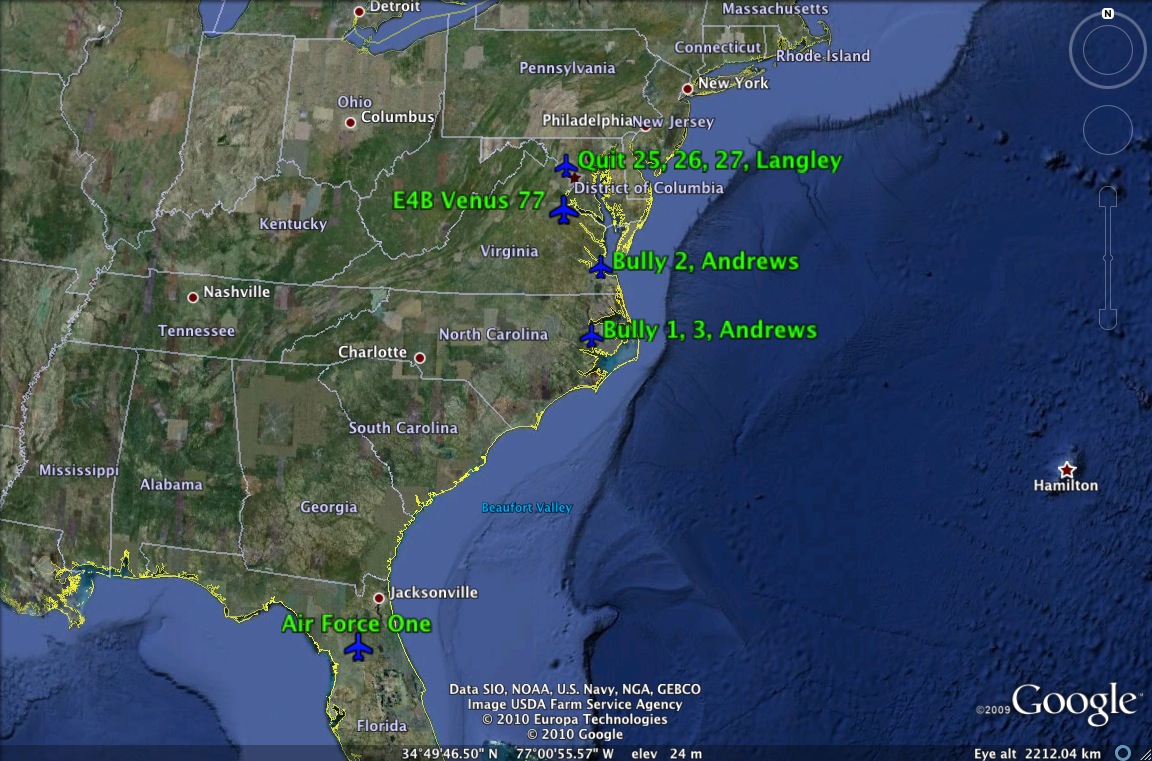Preamble (added Nov 30, 2010)
Here is a link to Vigilant Guardian information from NEADS as contained in the records of the 9-11 Commission. This clarifies the hours of the exercise. According to an included email from Col Marr, NEADS Commnder, “Exercise VIGILANT GUARDIAN N0 1-2 is a NORAD-sponsored Transition to Wartime Operation Command Post exercise that will be conducted in two phases: Crisis Action Team (CAT) Planning and 24/7 Operations. CAT Planning will be conducted from 20-31 Aug 01, weekdays only and 1/2 day play TBD by NORAD. The Operational Phase will be conducted from 1400Z 6 Sept 01 to 0200Z 9 Sept 01 and the 24/7 Operational Phase will be conducted from 10 Sept to 13 Sept.
Introduction
I am working with NARA to obtain copies of the NEADS audio files as they were originally provided to the Commission. In a first delivery, NARA provided DVD copies of the following three Commission documents, by accession number: RDoD0312646, 1 of 2, NEADS GSA Box 110; RDoD03012647, 2 of 2, NEADS GSA Box 110; and RDoD04020857, NEADS Dictaphone remake DRM1, GSA Box 141. The files are too massive for me to upload to RapidShare. I am looking for a work around to put the files in the public domain.
These three DVDs are not the files originally forwarded piecemeal to the Commission in the immediate aftermath of our first visit to NEADS and the resultant subpoena, NARA is still looking for those files. These files are .wav versions submitted to the Commission for the record. Of interest to researchers and historians is the fact that these files go back to September 3, 2001 and help document Exercise Vigilant Guardian.
Each subfile on the DVDs is for a specific day. For example, DVD 1 of 2 contains five subfolders for Sep 3 through Sep 7. The subfolder for Sep 4, the first day of the exercise, is D20010904DRM3-20010903-234840_DRM003_1.ARC. The first nine characters establish the date of the included files.
For each date there are two sub-folders. One is an Access .mdb file which provides the start and end times for each .wav file. The .wav files are conversation dependent and range in duration from a few seconds to more than 20 minutes. Many of the short duration files are dial tones.
The second sub -folder for each day contains folders for 24 channels. The Access file, printed out, will tell you which channels were recorded and which are empty. Knowing that will save time; one need only open the folders containing data. Once opened there is an additional single sub-folder which lists the .wav files by a sequence number (Zulu time) which can be correlated to the Access .mdb file. The size of each .wav file is included; it doesn’t take long to figure out which files are substantive and which are not.
One last point. It is near imperative to exploit the files using a program such as Adobe Audtion. Use of a media player will quickly lead to frustration. I use Adobe Audition in order to quickly find conversations, identify dial tones, and, when necessary, amplify background conversations.
Here is Exercise Vigilant Guardian based on the audio files provided by NARA. In this first article we start with the period Sep 3-6, 2001.
Exercise Vigilant Guardian
Vigilant Guardian was primarily a command post exercise controlled by a “sim cell” (simulation cell). Non-NORAD entities such as FAA were portrayed by the exercise controllers. The exercise was separate and distinct from the real world. Here are the highlights of the first days, Sep 4-6, 2001. As with every exercise in my experience, both field and command post, the pace starts slowly.
Monday, Sep 3, 2001.
Although an audio file was provided it appears to be a placeholder only.
Tuesday, Sep 4, 2001.
It is uncertain that the exercise itself started on this day. The day’s activity consisted of “evals,” evaluations for three controller teams. The scenario was defensive counter-air featuring blue on red forces operating over established training ranges, in this case Falcon Axe. The fighters were Burlington-based, Jaws call sign vs Grunge call sign. Each evaluation lasted 30-45 minutes the first beginning around 1pm (probably Zulu time, in context). The next two were at about 4:45 and 7:20.
Of interest, the first team was lead by Major Fox who would be the Senior Director on duty the morning of Sep 11, 2001. Demonstrably, Fox was the best of the three, his competence and confidence come through loud and clear. Here are some audio segments which highlight the days activity.
Fox’s voice identified. In the following clip we clearly hear the voice of Major Fox; those familiar with the NEADS tapes will recognize him immediately. In an earlier floor conversation he did identify himself by name. Here he gives a succinct description of the mission in which he places the opposing fighters (Grunge) as the DCA [defensive counter-air] force. 0904122350 Fox describes DCA
Fox puts Vigilant Guardian in contest. In the following clip Major Fox distinguishes “VG” (Vigilant Guardian) from the evaluations and establishes that the time is before 10:00 local. 0904122918 Fox Vigilant Guardian Perspective
Fox’s fighters, Jaws, declare “Miller Time.” In this clip Major Fox is heard directing a successful attack. 0904131130 Miller Time and Success
The entire engagement directed by Fox is in the audio files, primarily sequence number 130713. Later files describe the second two evolutions of the day, similar to the engagement directed by Fox. A better description of the defensive counter-air mission is included in sequence number 161531. 0904162726 Mission Described The language is cryptic and mission-specific. Readers familiar with the language of air defense training will appreciate the insight into NEADS operations.
There was no other activity recorded on Sep 4, 2001; the day was devoted to controller evaluations at NEADS.
September 5, 2001
There was little, if any, discernible exercise activity. There was one additional combat air engagement, similar to the three events on September 4. That additional event does provide specific examples of how air-air combat exercises were started and terminated. In this case HUNTRESS was controlling a flight with call sign Mad Dog.
The battle begins 0905191547 Fights On, and ends 0905193437 Knock it off. HUNTRESS ended its control by handing the Mad Dog flight off to GiantKiller. 09055193822 Contact GiantKiller. I have discussed GiantKiller in other articles. It is the military (Navy) control center for designated military training areas. It is located in Virginia Beach, VA., and operates using FAA procedures. GiantKiller would have handed the flight off to the appropriate FAA Center for the return flight to base.
The only other notable activity in the audio files is the HUNTRESS ID section validating and verifying the “modes and codes” with several military planes, a procedural test possibly part of the exercise. Here is one example. 0905155326 Swordfish Mode Check
September 6, 2001
The day started slowly but picked up pace in the evening. Here are selected audio clips of interest.
First is a clip of a late afternoon simulated scramble of two fighters, HOPS 71 and 72 from Langley. The scramble call is made to the simulation cell. 0906174716 Simulated Scramble Langley
Second is an evening call to the simulation cell which clearly shows that the exercise equipment was separate from real world and that the controllers did not want all the exercise equipment to be functional. 0906182747 Exercise Equipment Separate
Third is a background announcement shortly after 8pm announcing that exercise hours would be 1000-2200 hours each day, including weekends, until 24-hour manning was required. I amplified the conversation and suppressed some of the clicks for clarity. 0906200336 Exercise Hours
Fourth is a conversation concerning a special track on a Aeroflot flight, JFK to Moscow. 0906201638 Aeroflot flight special track
Fifth is an extended discussion with the simulation cell about the hours of the exercise and a planned expansion. (The expansion will be one of coverage, NEADS will assume control for WADS (Western Air Defense Sector) while they do a planned evacuation. More on that later.) 0906201733 Expansion
Sixth is clear evidence that the simulation cell was simulating all outside agencies, in this case Giantkiller and FAA’s Washington Center. The issue is a C-130 that is squawking 7700. Listen as the exercise team discusses the situation. Note that Huntress ID goes down a check list and asks the key question, “requesting any assistance?” 0906202145 C130 squawking 7700
That is an important point. The hijack procedures in place on Sep 11, 2001, required an FAA request for assistance. The only hijacked plane on 9-11 for which NEADS assistance was requested was AA 11; the request came from Boston Center.
Seventh is an admission by the simulation cell that they started an exercise inject one hour early. NEADS, therefore, initiated a “Jersey Scramble” early. The Commission records obtained from Atlantic City define the Jersey Scramble as the standard lanuch of Atlantic City fighters, 090 for 90 (head East for 90 nautical miles). Note the similarity to the standard launch from Langley, 090 for 60, which is the heading, direction and distance the Langley fighters went on the first leg of their flight to the nation’s capital on 9-11. This Jersey Scramble, if properly in sequence, most likely pertained to the C-130. 0906203024 Sim Cell started inject early
Eighth is a “May Day” call from the simulated C-130 in distress, Cargo 45. 0906203853 Cargo 45 May Day
To be continued, Sep 7, 2001 is next.

